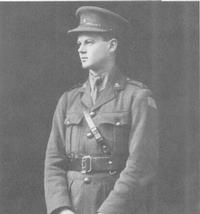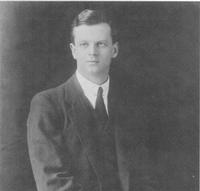


Flyleaf
Online Edition
Title Page
Imprint
Message
Tribute
Foreword
Table of Contents
Contributors
Sir Lindesay Clark
Introduction
Index
Search
Help
Contact us

On his return, Lindesay Clark attended the University of Melbourne, where he qualified as a Bachelor of Mining Engineering in 1920. To him, the move into mining seemed a foregone conclusion.
'Well, really I never thought of doing anything else, because I was brought up on a mine and I was brought up in a way which was so interesting, because my father was so competent,' he remarked during an oral history interview for the National Library of Australia in 1976. 'I had a sort of an apprenticeship with him as well as my work at the University.'
'When I came back from the war I was determined to get through my course. I'd done the science course in Tasmania and that let me off the first two years of the mining course (in Melbourne), so I finished (it) in two years.'
The course then included not only mining but also metallurgy. To further his special interest in the latter, Clark began work at the Sulphide Corporation's lead smelter at Cockle Creek.
'I reached the high office of Assistant Metallurgist and, with the concurrence of management I set up a scheme for trying to reduce the voltage across an electrolytic cell for electrolytic zinc. It didn't work out, but I learnt a lot out of doing that. And I learnt a bit about lead smelting, which was a useful thing to know.'

In 1922, Clark returned to Melbourne to work with his father, who was then a consulting engineer for the State Electricity Commission of Victoria, which was developing the Yallourn coal deposits for electricity generation, under the leadership of Sir John Monash.
In the following year, Lindesay Clark was awarded a Master of Mining Engineering degree at the University of Melbourne, where for the next ten years or so he was an independent lecturer in mining as well as an assistant to his father and later a consulting engineer in his own right. This led to a number of expeditions to examine mining properties in remote parts of central Australia, Queensland and Papua-New Guinea. Once again, the young dark was to see at first hand the problems of remote mining communities. Lengthy journeys by sea and rail continued, as well as uncomfortable journeys on horseback, during which he usually camped in crude bush dwellings.
'The University found it hard to get men, practising men, and they allowed me to have some irregularity in my lectures, otherwise I couldn't have done it. I put in the number of lectures, but not regularly three a week. Some weeks I'd do four or five lectures and then get away for a few weeks,' Sir Lindesay recalled in the 1976 interview.

Organisations in Australian Science at Work - Sulphide Corporation
 |
Australian Academy of Technological Sciences and Engineering |  |
© 1988 Print Edition pages xiv - xv, Online Edition 2000
Published by Australian Science and Technology Heritage Centre, using the Web Academic Resource Publisher
http://www.austehc.unimelb.edu.au/tia/xii.html